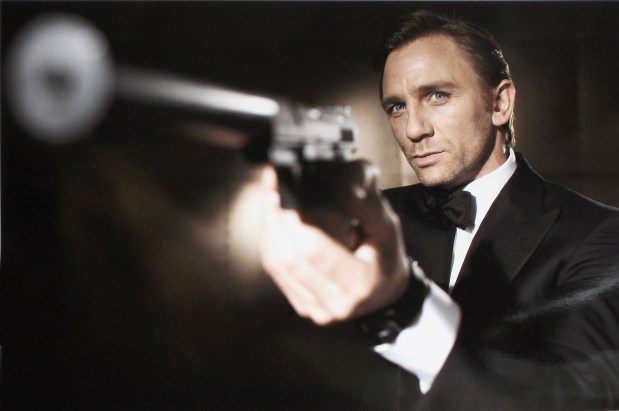It started in January 1952, when a hard-drinking, chain-smoking 43-year-old man sat down at a typewriter in his house in Jamaica and at a frenetic 2,000 words a day, banged out a novel that began, “The scent and smoke and sweat of a casino are nauseating at three in the morning. Then the soul-erosion produced by high gambling — a compost of greed and fear and nervous tension — becomes unbearable and the senses awake and revolt from it.”
The next paragraph would give the world one of its most enduring and popular fictional characters, when Ian Fleming typed, “James Bond suddenly knew that he was tired. He always knew when his body or his mind had had enough and he always acted on the knowledge. This helped him to avoid staleness and the sensual bluntness that breeds mistakes.”
This book, “Casino Royale,” was the birth of Bond and paved the best-selling path for more books, a movie franchise that has made billions and, as of last week, the Museum of Science and Industry’s “007 Science: Inventing the World of James Bond,” touted as the “first-ever official exhibition to focus on the science and technology behind the world’s longest-running movie franchise.”
That exhibit of gadgets and gizmos runs through Oct. 27 but in the meantime, I thought I would reread some Bond novels and dig a bit deeper into the life of Ian Fleming.
Fleming fascinates and there have been many biographies since his 1964 death from a heart attack. I have read a few and just finished the most recent (and the best), a 864-page triumph titled “Ian Fleming: The Complete Man,” by Nicholas Shakespeare. It was called, by London’s Sunday Times, “A monumental record of Fleming’s life. The completeness of the book is beyond doubt. Shakespeare leaves no future biographer much to discover. Fleming’s place in history is assured.”
Using rare access to the Fleming archive, Shakespeare fashions an exciting and often sad portrait of the man. It is rich in detail, such as Fleming’s claim to have written the first Bond novel as a distraction from his upcoming wedding to an aristocratic but eccentric Ann Charteris, about whom he wrote in a letter, “We are, of course, totally unsuited. I’m a non-communicator, a symmetrist, of a bilious and melancholic temperament … Ann is a sanguine anarchist / traditionalist. So china will fly, and there will be rage and tears.”
The book is terrific and compelled me to get in touch with a local writer who is as knowledgeable about Fleming and Bond as anyone I know.
His name is Raymond Benson and he lives in the northwest suburbs. He first encountered Fleming and Bond when his father took him to see the movie “Goldfinger” in 1964. He was 9 years old and he was hooked for keeps, devouring all the novels, seeing all the films.
After college and a career in theater, he would write “The James Bond Bedside Companion,” which was published to considerable acclaim in 1984.
In 1996, he got a call from representatives of the Ian Fleming estate asking if he’d like to tackle writing a Bond novel, as others had done after Fleming’s death. “I jumped at the opportunity,” he said.
He would write six original Bond novels, three novelizations of Bond films and a few short stories. After Bond, he started a career as a prolific and quite good novelist, teacher and cinema showman, and giving public presentations (with former Daily Herald film critic Dann Gire) about movies called “Dann & Raymond’s Movie Club.”
Over the weekend he expressed his admiration for Fleming, telling me, “He was a man who had intense energy, curiosity, and a mind for detail and organization. He extracted ideas and fine points with the fervor of a sharp detective, scribbling down notes in a little pad which he always kept with him. He was the sort of person who wanted to know a little about everything.”
Not surprisingly, he has seen the MSI exhibition and calls it fascinating.
“It has something there for everyone, whether you’re a fan or not,” he says. “Interactive displays and games will entertain younger visitors, even if they don’t know the Bond movies. As someone who grew up with the Connery-era pictures, my favorite pieces are early ones, such as Rosa Klebb’s knife-shoe that was in ‘From Russia with Love’.”

Last year Ian Fleming Publications celebrated the 70th anniversary of “Casino Royale” by republishing in the UK all of Fleming’s books, but they also republished out-of-print titles by some of the continuation authors, including Benson’s first Bond novel, “Zero Minus Ten.” Also, two weeks ago came “James Bond: The Raymond Benson Years,” an e-book omnibus of all six of Benson’s original Bond novels, published 1997-2002.
There has ever been speculation about the inspiration for Bond.
Benson tells me, “While Fleming certainly knew Bond-like agents during the war, most 007 scholars agree that the character was a wish-fulfillment embodiment of Fleming himself. Bond was the man that Fleming wanted to be.”





